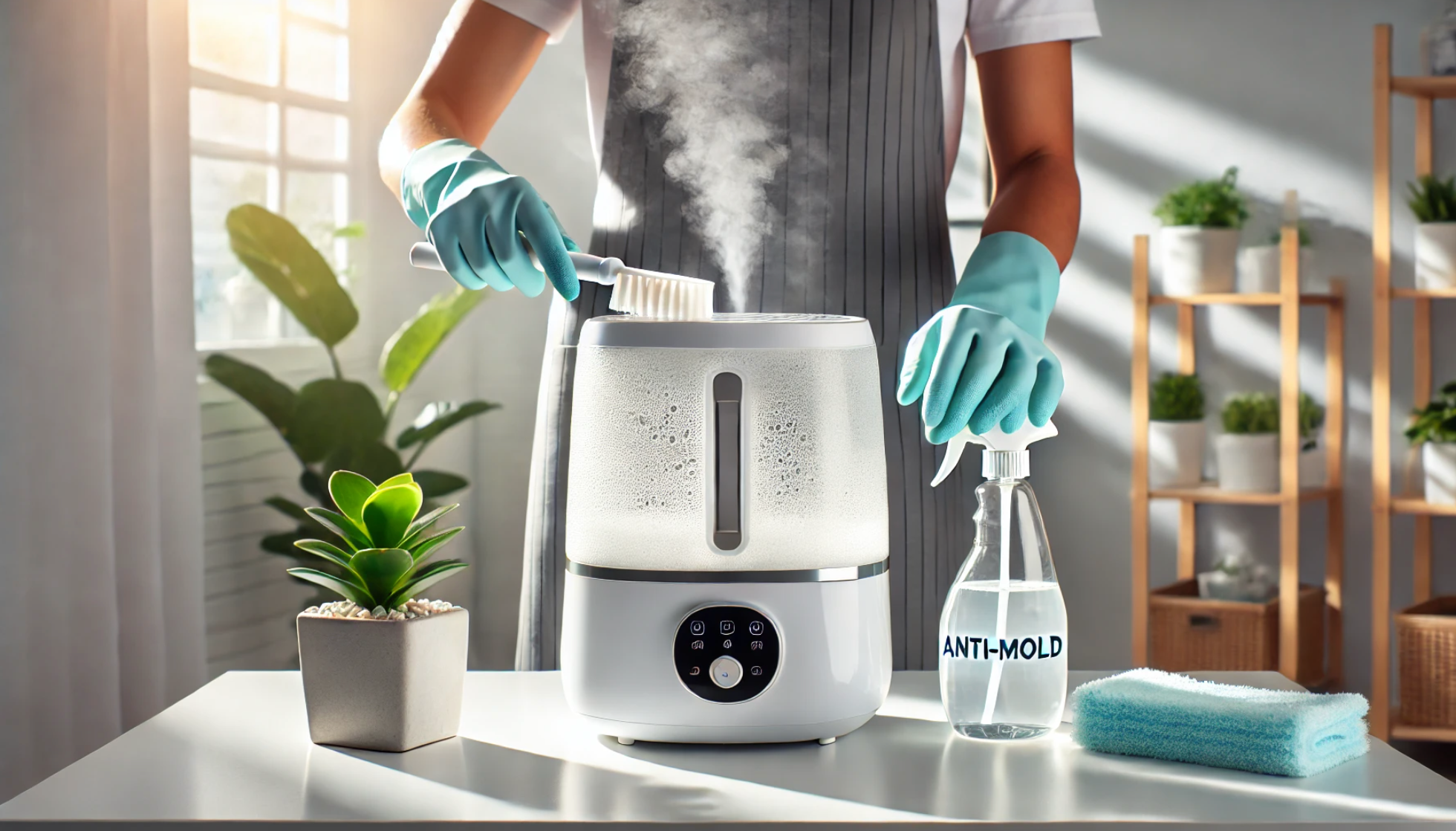How To Prevent Mold In Humidifiers: Vaporizer, Cool Mist, Whole House
Mold growth in humidifiers is a common issue that can be both unpleasant and potentially harmful to health. Many people who use humidifiers to increase air moisture levels may encounter this problem.
The discovery of mold in a humidifier can be concerning. It often presents as dark spots or a musty odor when the device is opened. This situation is not uncommon, and many humidifier users seek ways to prevent mold growth.
This guide will present effective methods for maintaining a clean, mold-free humidifier. The focus will be on practical strategies to ensure the device produces clean air without unwanted contaminants.
To prevent mold in humidifiers, including vaporizers, cool mist, and whole house systems, use distilled or demineralized water to reduce mineral deposits. Sanitize your humidifier every 3 days with a 3% hydrogen peroxide solution or vinegar. For whole house humidifiers, install a UV light near the unit to inhibit mold growth in ducts, and consider flow-through models with a drain to prevent water stagnation. Use a smart thermostat to control humidity based on outdoor temperature, keeping levels between 30-50%. Clean the humidifier regularly, including the water panel and tray, and replace filters annually, preferably at the heating season’s start. Use Agion-coated pads or filters to inhibit biological growth. In cool mist humidifiers, add tea tree oil or a bacteriostatic treatment. For vaporizers, boil water before use. Also, monitor condensation on windows and adjust humidity accordingly. Some users report success with adding silver coins or colloidal silver to the water tank to prevent mold and bacterial growth. A 50/50 Propylene Glycol solution is also suggested for charging humidifiers to prevent mold.
Why Does Humidifier Get So Moldy?
Humidifiers become moldy due to high humidity (>60%), stagnant water, poor design, and inadequate maintenance. Factors include water quality, humidifier type, temperature, and cleaning frequency.
Now, let’s discuss each factor that causes molds in humidifier:
1. High Humidity Level
Humidifiers create ideal mold conditions when humidity exceeds 60%. This excessive moisture, especially in poorly ventilated spaces, fosters fungal growth. The high moisture levels, combined with stagnant air, create a perfect mold habitat. Ventilation plays a crucial role. Opening windows periodically can significantly reduce mold risk by promoting air circulation and reducing humidity.
2. Water Quality And Stagnation
Water quality significantly impacts mold growth in humidifiers. Tap water, rich in minerals and microorganisms, feeds mold. Even distilled water, often considered safe, can become a mold haven if left stagnant.
A parent discovered this when mold grew in their baby’s humidifier despite using distilled water and frequent refills. Stagnant water allows microorganisms to multiply rapidly, forming biofilms that adhere to humidifier surfaces. These biofilms, slimy layers of microorganisms, often go unnoticed but harbor mold and bacteria even when the device appears clean.
Featured Snippet: Humidifiers become moldy due to high humidity (>60%), stagnant water, poor design, and inadequate maintenance. Factors include water quality, humidifier type, temperature, and cleaning frequency. Prevention involves regular cleaning with vinegar or hydrogen peroxide, using distilled water, and choosing easily cleanable models.
3. Design Flaws And Material Choices
Humidifier design often inadvertently promotes mold growth. Deep crevices, small openings, and hard-to-reach areas create perfect hiding spots for moisture and organic material.
A user struggled with a Walmart humidifier’s mold-prone areas, highlighting this common design flaw. Filter-type humidifiers seem particularly susceptible. Users report slimy green, yellow, and black substances on filters after brief use.
Material choice also influences mold growth. Clay humidifiers, for example, can develop a mildew smell even when seemingly clean, suggesting porous materials might encourage microbial growth.
4. Maintenance And Cleaning Practices
Insufficient cleaning is a major factor in humidifier mold growth. Many users underestimate the required maintenance frequency. Weekly, or even daily, cleaning is often necessary to prevent mold.
Proper maintenance involves disassembling the device, thoroughly cleaning all components, and ensuring complete drying before reassembly. Using a vinegar solution (one part vinegar to one part water) effectively combats mold. Some users successfully use additives like essential oils (lemongrass, bay, oregano) or polysorbate 20 to inhibit microbial growth.
5. Humidifier Type
The type of humidifier and its operating temperature play crucial roles in mold growth. Different humidifier designs create varying environments that can either promote or inhibit mold proliferation.
Ultrasonic and impeller (cool mist) humidifiers are more prone to mold growth due to their design and operation. These types of humidifiers disperse moisture into the air through ultrasonic sound vibrations or a high-speed rotating disk, respectively.
The dispersed moisture can carry microorganisms, including molds, from the water tank into the indoor air. The water tanks in these humidifiers often contain standing water, which provides an ideal breeding ground for mold and other microorganisms.
For example, if the water in the tanks is not changed frequently or if the tanks are not cleaned properly, mold can quickly proliferate. The risk of mold growth is exacerbated when tap water, which contains minerals, is used. These minerals can create deposits within the humidifier, providing additional surfaces for mold to grow.
This situation is less common in evaporative and steam vaporizer humidifiers, which either use a fan to blow air through a moistened absorbent material or create steam by heating water. These types do not generally disperse significant amounts of microorganisms or minerals into the air, reducing the risk of mold growth.
Warm mist humidifiers, which boil water to produce steam, are generally less prone to mold growth because the boiling process kills most mold spores and bacteria. However, the water reservoirs in these units still require regular cleaning to prevent mold growth in stagnant water.
How To Prevent Mold In Humidifiers?
Here are the steps you can follow to get rid of mold in humidifiers:
1. Empty The Water Reservoir Daily
To prevent mold, empty the water reservoir of your humidifier daily. Stagnant water is a prime breeding ground for mold spores. Once emptied, thoroughly dry the reservoir to ensure no residual moisture is left.
2. Clean With White Vinegar Or Disinfectant
Each week, perform a more thorough cleaning by soaking the base and reservoir in a solution of white vinegar or a manufacturer-recommended disinfectant for about 30 minutes. This helps dissolve mineral buildup and kill mold spores. After soaking, use a soft brush to scrub all surfaces, and rinse thoroughly with clean water to remove any remaining cleaning solution
3. Deep Cleaning And Inspection
Conduct a deep cleaning of the humidifier every month. Disassemble the unit and inspect all parts for signs of mold or mineral buildup. Soak particularly dirty or moldy parts in a potent disinfectant solution for an extended period if necessary. Replace any filters, as they can harbor mold and bacteria if not regularly changed.
4. Use Distilled Or Demineralized Water
Tap water contains minerals that can promote mold growth. Using distilled or demineralized water reduces the potential for mineral deposits, making the environment less favorable for mold.
5. Ensure Proper Ventilation
Proper ventilation in the room where the humidifier is used helps control indoor humidity levels, preventing excess moisture that can lead to mold growth. Use a hygrometer to monitor humidity levels, keeping them between 30-60%.
6. Clean Portable Humidifiers Every Three Days
Empty the tank, use a brush to clean it, remove any scale, deposits, or film, and wipe all surfaces dry. Unplug the unit before cleaning and follow the manufacturer’s recommendations for cleaning products or disinfectants. If no recommendations are provided, a 3% hydrogen peroxide solution can be used.
7. Adhere To Manufacturer’s Instructions For Console And Central Humidifiers
Follow the manufacturer’s directions on cleaning and maintenance for console and central humidifiers. Ensure the water in the tank is not left standing for extended periods and remains clean.
8. Prevent Dampness Around The Humidifier
Ensure that the area around the humidifier does not become damp or wet. If dampness occurs, reduce the humidifier’s output volume or use it intermittently. Keep absorbent materials like carpeting, drapes, or tablecloths dry.
9. Follow End-of-Season Maintenance
At the end of the season, clean the humidifier thoroughly, ensure all parts are dry, and dispose of used demineralization cartridges, cassettes, or filters. Store the unit in a dry location and clean it again after storage to remove any dust on the outside.
10. Check And Clean Furnace Humidifiers Regularly
Ensure furnace humidifiers integrated into the HVAC system are checked and cleaned regularly to prevent mold and bacterial growth. Inspect ducts where humidifiers are installed to ensure no water has leaked into the furnace or filter areas.
What To Put In Your Humidifier To Prevent Mold?
You can use following additives to prevent mold in humidifier:
- White Vinegar: Add a small amount to the water tank. It’s natural and effective, but be cautious as it may corrode metal parts over time.
- Hydrogen Peroxide: Great for cleaning and can be added to the water. A study showed it’s only slightly irritating at 2.2 ppm in air, but not at 0.5 ppm.
- Tea Tree Oil: A few drops can work wonders due to its antimicrobial properties.
- Bacteriostatic Treatments: Specially formulated for humidifiers, these are particularly good for evaporative types.
- Silver and Copper: Some swear by adding a silver dollar or copper penny to the tank. These metals have natural antimicrobial properties.
- Propylene Glycol Solution: Popular in cigar humidors, a 50/50 solution with distilled water can prevent mold.
- Lemon Slices: A natural option that can help inhibit microbial growth.
- Essential Oils: Lemongrass, bay, and oregano have antimicrobial properties. But be careful – not all humidifiers are compatible with oils.
You should keep in mind these things before using additives in the humidifier:
- Always check your humidifier’s manual first: Some manufacturers have specific recommendations (or warnings) about using additives.
- Less is more: Start with small amounts of additives and see how it goes. You don’t want to turn your humidifier into a science experiment gone wrong!
- Regular cleaning is still a must: Even with additives, you’ll need to clean your humidifier regularly – about every three days, according to the EPA.
- Be cautious with essential oils: While they smell great, not all humidifiers are designed to handle them. Using oils in the wrong type of humidifier can actually damage it.
Should You Throw Away A Moldy Humidifier?
Yes, you should throw away a moldy humidifier, especially if:
- There’s black mold present
- You have asthma or are sensitive to mold
- The mold keeps returning despite cleaning attempts
- You can’t thoroughly clean all parts of the humidifier
Many experts and users recommend replacing moldy humidifiers rather than attempting to clean them, as mold can pose serious health risks including respiratory issues and allergic reactions. The consensus is that it’s safer and more cost-effective in the long run to buy a new, mold-free humidifier rather than risk ongoing exposure to mold spores from an incompletely cleaned device.
Is It Bad To Breathe In Mold From Humidifier?
Yes, it is bad to breathe in mold from a humidifier. A moldy humidifier isn’t just an aesthetic issue; it poses serious health risks. Mold spores released into the air can cause or exacerbate respiratory problems, allergies, and other health concerns. This is especially dangerous for vulnerable groups like infants, the elderly, or those with pre-existing respiratory issues. The potential health impacts underscore the importance of maintaining a clean, mold-free humidifier.
Protect Your Indoor Air Quality With Our Mold Removal Services
If mold from your humidifier has spread to other areas of your home, you should address the issue promptly to protect your health and property. At Mold Removal Memphis, we provide professional mold remediation services to ensure your home is safe and mold-free. Contact us today for a thorough inspection and effective mold removal solutions. Take action now to safeguard your living environment.

